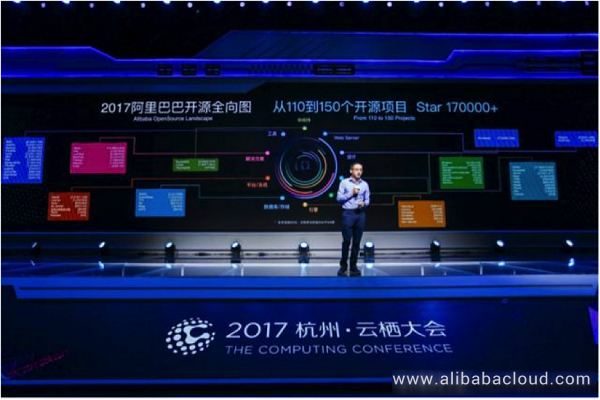Since last year, the LinuxCon + ContainerCon + CloudOpen China (LC3) conference had entered China at the time when open source cloud computing was booming in the technical circle in China, attracting more attention from international counterparts.
Besides classic open source topics, the LC3 conference focuses on current hot technical areas such as AI, deep learning, blockchain, container, serverless, microservices, and automatic orchestration. The LC3 conference is hosted by the Linux Foundation, which develops from the Linux project at the beginning to many excellent projects today such as Kubernetes, CNI, Containerd, DPDK, and Xen and several sub-foundations such as CNCF, CF, Hyperledger, and ONAP.
Alibaba Cloud has always kept compatible with the community's open source standards. For example, Alibaba Cloud is one of the first platforms that passed Kubernetes consistency authentication, supported Containerd 1.1, provided the high-performance network Terway plug-in, and supported open source tools such as CNI, Helm, and Istio. The Alibaba Cloud platform also supports the use of deep learning frameworks such as Trensorflow and Caffe and blockchain frameworks such as Hyperledger. Meanwhile, Alibaba Cloud has proactively joined many renowned international open source organizations, including the Linux Foundation, CNCF, CF, Free Software Foundation, and Apache Software Foundation.
Open source is an inevitable trend in the primary technology field. It is evident that a basic technology without getting open sourced does not have vitality as its broad use is difficult. The development history of open source software brings excellent reference value to people inside and outside the software industry.
Upgradation and sophistication of the entire technology will occur after the extensive use of an open source project in business. Earlier, this process may have taken three, five, or even ten years. However, with open source, it is possible within months.
The most well-known open source software is the Android system. Statistics show that 81.7% of mobile users are using the Android system currently, which is undoubtedly one of the most influential software. Without this open source functionality of Android, there may not be so many mobile phones and related ISVs. It is unpredictable when a similar mobile Internet ecosystem will come.
Linux is indeed one of the most successful open source software in both its current ecosystem building and technical evaluation. Linux has also contributed and laid the foundation for today's cloud computing. Hadoop, Spark, and OpenStack are evidently successful. These open source projects use underlying technologies and support development of big data and cloud computing.
Another example is the ApsaraCache project of Alibaba Cloud ApsaraDB for Redis. Before making it open source officially, this project has been technically improved for four years and tested in more than 10,000 instances in the production environment. As said by the Redis founder Salvatore, it is marvelous to open the source code of ApsaraCache as it can attract more Redis core specialists worldwide to participate in the project and further improve stability and availability of the product. He also said that Alibaba Cloud is capable of developing Redis products. He hoped to work with Alibaba Cloud together to further improve the product features.
The open source technologies have penetrated into various fields; including operating systems, databases, compiling toolchains, web servers, today's distributed system management projects, deep learning frameworks and tools, and different blockchain technologies. They also reflect the trends and dynamics of the technical circle, increasing its vitality. From another perspective, the growth of open source supports the business development because many customers hope to gain business support and values.
The entry of LC3 into China indicates that unlike the past, Chinese enterprises now become increasingly important in the open source field. Almost all representative enterprises in China's IT industry are playing an essential role in the open source field. They have now become one of the leaders in the open source world instead of requesters in the past. Vendors outside China are more interested in the Chinese open source environment with latecomer advantages compared with European and American enterprises with decades of software development history.
Chinese software companies can utilize reliable technologies that have been verified by their counterparts. With this advantage of open source, these companies can use new technologies faster than their Western counterparts. Instead of thinking about how to cultivate the open source field, Chinese enterprises need to consider how to excel in this field.
Chinese enterprises have already worked on open source to adapt to the era of enterprise-level market bursts. Some enterprises have already run far ahead of their competitors. Alibaba Cloud, with the open and win-win genes, has instinctively chosen the way of open source. Alibaba Cloud is always proactively cooperating with international open source organizations and is an active developer of Linux. It has submitted more than 290 patches for the Linux kernel, making the most significant contribution among all Internet companies in China. In the latest organizations ranking released by GitHub, Alibaba has risen to the sixth place and has more than 150 open source projects.
The Computing Conference is a perfect window to observe the movements of the Alibaba family. This conference shows Alibaba's determination in the open source road. In the Computing Conference 2017 in Hangzhou, Jeff Zhang, CTO of Alibaba Group, publicly demonstrated Alibaba's open source omnidirectional map from 110 to 150 open source projects, Star 170000+, and from device to cloud, IoT, and intelligent full-stack technology feedback.

Chinese enterprises have gradually become trendsetters in the open source world, especially in the enterprise-level market. With the development of emerging technologies such as cloud computing and IoT, open source faces both challenges and unprecedented opportunities. Chinese enterprises are expected to catch up with competitors in the new wave of technology, and Alibaba Cloud will keep moving forward in the wave of open source.
Alibaba Cloud does not aim to show its strength in the open source field. Instead, it wants to invite more and more top engineers through open source to make progress together in the multi-scenario application. Early in 2012, Alibaba Cloud's open source technology has bloomed on the cloud. The following are some classic examples.
In 2012, the third-generation distributed message-oriented middleware RocketMQ announced its open source. Behind each transaction of millions of users, RocketMQ undertakes the message flow of the Alibaba Cloud production system. In the 11/11 shopping spree in 2016, RocketMQ successfully undertook a record transaction peak (175,000 transactions/second) and guaranteed that the message delay time of 99.996% was within ten milliseconds.
Also, in the Computing Conference 2016, many people witnessed that the status of the AliSQL code library on GitHub changed from Private to Public. The handshake between Michael Wideneus (father of MySQL) and Chu Ba (father of AliSQL) indicated the continuous advancement of the database technology in the cloud development process.
Last year, Alibaba launched the OpenMessaging project and developed the distributed message-oriented middleware and streaming application development standard together with Yahoo, DiDi, and Streamlio. Currently, this standard has officially entered the Linux Foundation. It is the first international standard in the distributed message field that is launched worldwide from China. This standard provides an open API that can interconnect with other measures without the limitation of programming languages. It meets the enterprises' requirements for scalability, isolation, and security. Moreover, it provides large-scale industrial support and assists adding of standard reference points and standardized tests.
In the LC3 conference in 2018, Alibaba Cloud officially announced the open source of the MongoShake data replication platform, which can replicate data across data centers with a maximum processing capability of up to 500,000 QPS. This platform enables efficient disaster recovery and multi-active business across data centers. It solves the problems of inflexible deployment and disaster recovery of multiple data centers and single-point writing, brings convenience to the company, and reduces the O&M pressure. Compared with the existing solutions in the industry, it provides better features and improved performance.
Year by year, Alibaba Cloud keeps moving forward in the open source field. As mentioned before, Alibaba Cloud does not aim to show its strength in the open source field. Instead, it wants to invite more and more top engineers to make progress together in the multi-scenario application by starting from open source technologies.
Read similar blogs and learn more about Alibaba Cloud's products and solutions at www.alibabacloud.com/blog.
Intelligent Manufacturing with ET Industrial Brain Open Platform
How Alibaba Cloud Evaluates Customer Product Reviews on Alibaba E-Commerce Platform

2,598 posts | 771 followers
FollowOpenAnolis - July 18, 2024
Alibaba Clouder - November 29, 2017
OpenAnolis - July 8, 2022
Alibaba Cloud Native Community - February 20, 2025
Alibaba Cloud Serverless - July 9, 2024
Alibaba Container Service - October 21, 2019

2,598 posts | 771 followers
Follow ECS(Elastic Compute Service)
ECS(Elastic Compute Service)
Elastic and secure virtual cloud servers to cater all your cloud hosting needs.
Learn More Tair (Redis® OSS-Compatible)
Tair (Redis® OSS-Compatible)
A key value database service that offers in-memory caching and high-speed access to applications hosted on the cloud
Learn More Container Service for Kubernetes
Container Service for Kubernetes
Alibaba Cloud Container Service for Kubernetes is a fully managed cloud container management service that supports native Kubernetes and integrates with other Alibaba Cloud products.
Learn MoreMore Posts by Alibaba Clouder
Start building with 50+ products and up to 12 months usage for Elastic Compute Service
Get Started for Free Get Started for Free